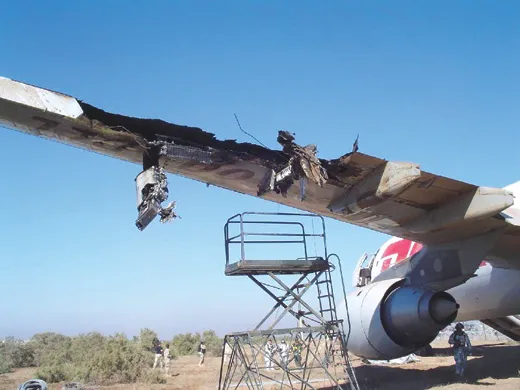Landing in Baghdad
At the world’s most dangerous airport, it’s best to get down quickly.
/https://tf-cmsv2-smithsonianmag-media.s3.amazonaws.com/filer/baghdad_388-nov06.jpg)
Looking out the window during final approach, you see the flaps extend and feel the landing gear drop down and lock into place. The aircraft rolls abruptly and begins spiraling downward like a slowly turning bit in a power drill. By the time you figure out what’s happening, the wheels touch ground with a reassuring thud and the airplane rolls to a safe stop on the runway.
What was that?
Before jumping out of your seat to complain to the pilot, consider the good news: You’ve just avoided being shot down by a missile. Welcome to Baghdad International Airport.
Hundreds of civilian aircraft take off and land at Baghdad International every week. These aren’t the friendliest of skies, however. Outside the heavily defended airfield perimeter are bands of insurgents who occasionally target civilian and military aircraft with surface-to-air missiles. To avoid being knocked out of the sky, pilots employ an old, trusted tactic: the spiral, or corkscrew, landing approach. Once the plane arrives at about 18,000 feet—still safely beyond the range of weapons like the SA-7 shoulder-fired missile—the pilot banks sharply and descends toward the runway in a slow, tight circle, like someone walking down a spiral staircase. During the spiral the crew keeps an eye out for other air traffic, and for anything coming at them from the ground. After several turns, the pilot pulls out of the rotation with careful timing, straightens out, and lands. The whole thing takes seven to 10 minutes, roughly the same as a regular approach, but it all takes place directly overhead, instead of beginning 20 miles from the runway.
Though it sounds like something from a flying circus, the corkscrew is actually a straightforward tactic that uses fairly standard piloting skills. Airline pilots sometimes use a similar maneuver, descending quickly through clouds to get under bad weather. With a little on-the-job training, spiraling down to the runway becomes second nature, says Kurt Neuenschwander, international chief pilot for Air Serv International, a nonprofit organization that flies relief workers and supplies into Iraq. Landing in Baghdad, he has flown Embraer 120s, which can handle a maximum bank angle of 60 degrees. Neuenschwander keeps it under 55 to be safe.
Initially the spiral was used only sporadically by pilots flying into Baghdad, until a near-disaster in November 2003 convinced everyone to give it a second look. A shoulder-fired missile ignited a fuel tank on a DHL Airbus A300 cargo jet that had just left the runway. The resulting fireball set the left wing ablaze and knocked out all hydraulic systems. With thick funnels of smoke pouring from their airplane, the crew used engine thrust to control the aircraft, turn it around, and make an emergency landing—just barely. It was a remarkable feat; the pilot had recalled the experience of Al Haynes, who managed to land his United Airlines DC-10 without hydraulics in Sioux City, Iowa, in 1989 using only engine thrust. Since the DHL incident, most pilots flying into Baghdad have adopted the corkscrew as a standard evasive maneuver, even though it isn’t required.
No one’s quite sure where or when the corkscrew maneuver originated, but the tactic dates at least to the Vietnam War. “The spiral has been used for years into airports that have been secured militarily,” says Paul Botha, chief pilot for AirQuarius, a South African firm that operates twin-engine Fokker F28s for Royal Jordanian Airlines. “I first became aware of it during the war between South Africa and the South West Africa People’s Organization in Namibia during the 1980s.” Neuenschwander flew the corkscrew to avoid small-arms fire during the Sudanese civil war in 1994. “We were flying relief operations in and out of the country,” he says. “In many villages where we landed, rebel forces were within a mile and knew that we were coming.”
However nerve-wracking the corkscrew landing might sound, Botha says it isn’t terribly exciting for pilots. “Some of our captains call it boring, because you are flying in circles,” he says. But for passengers, particularly those making their first landing in Baghdad, the corkscrew can be intimidating. “You have no forward-looking vision,” notes Neuenschwander, “so if you’re looking out the side windows, you’re seeing either the sky or the ground. A lot of people tense up, especially if they don’t have much flying experience.” Flying into Baghdad on an Air Serv aircraft, journalist Betsy Hiel recalls “a woman across the aisle gritting her teeth so hard that she snapped one tooth off.”
For frequent fliers, the spiral descent actually has aesthetic advantages. “Coming in on a corkscrew affords a great view of Baghdad and of the airport,” notes Thanassis Cambanis, who has flown in and out of Iraq more than a dozen times on assignment for the Boston Globe. “To me, the plane doesn’t feel like it’s descending any faster than usual, so it’s not too frightening.” And compared to the prospect of a missile taking down your airplane, any landing, even a wild corkscrew ride, can be downright comforting.


